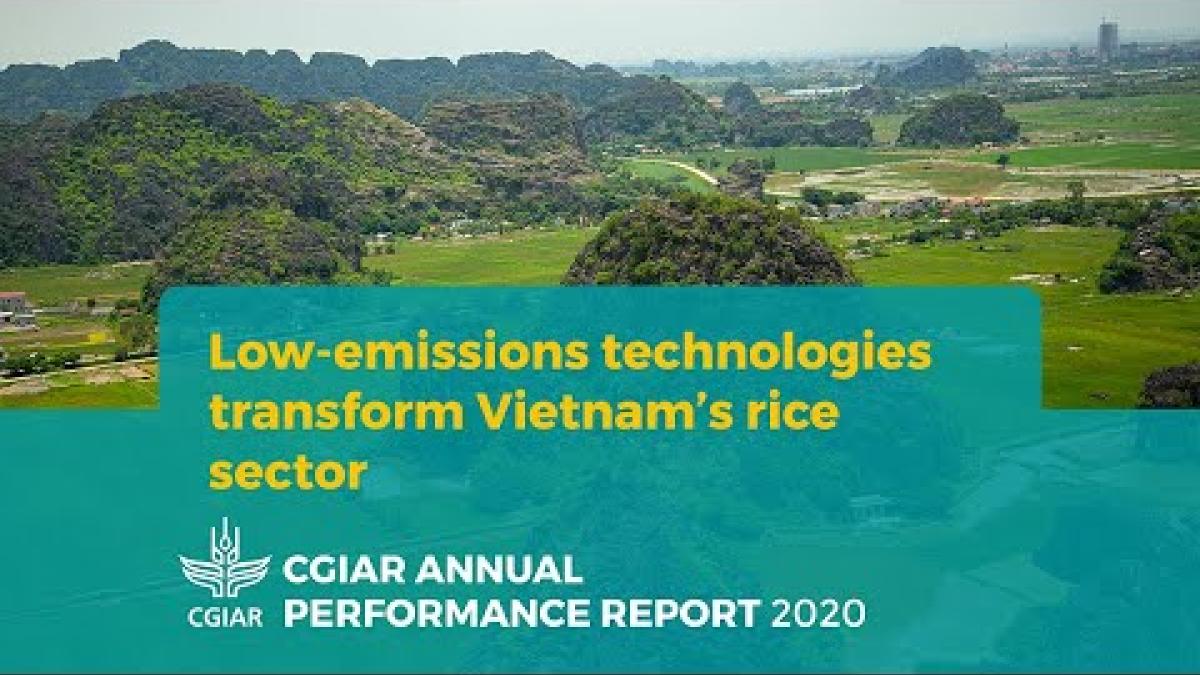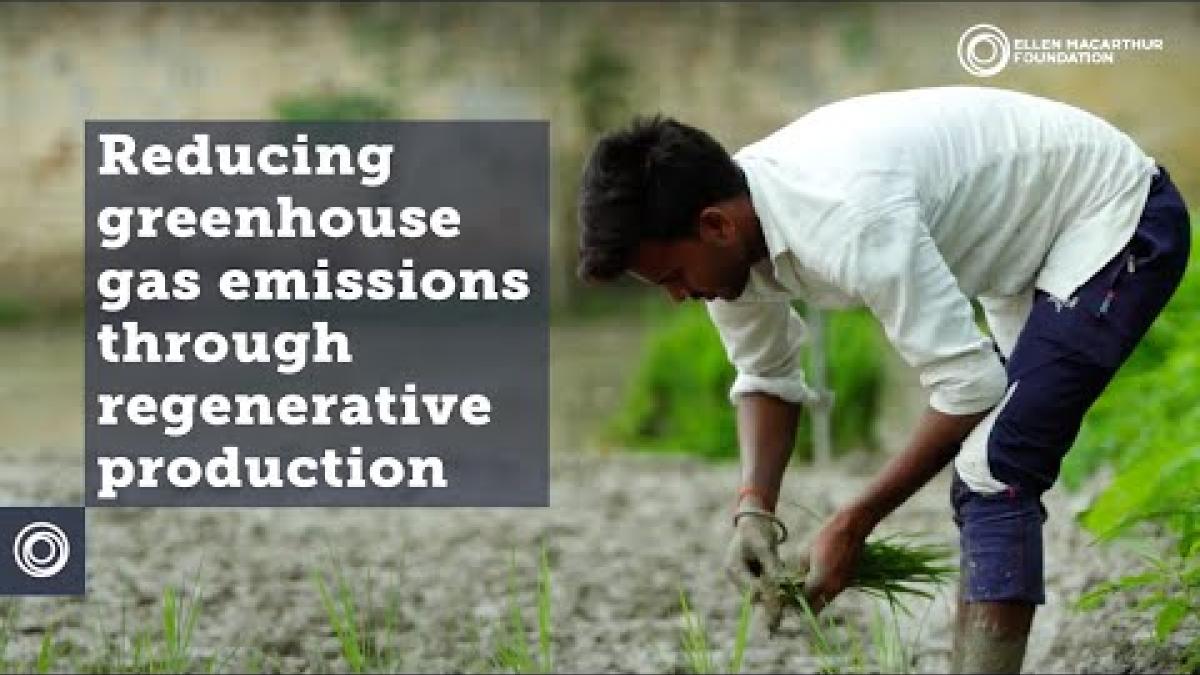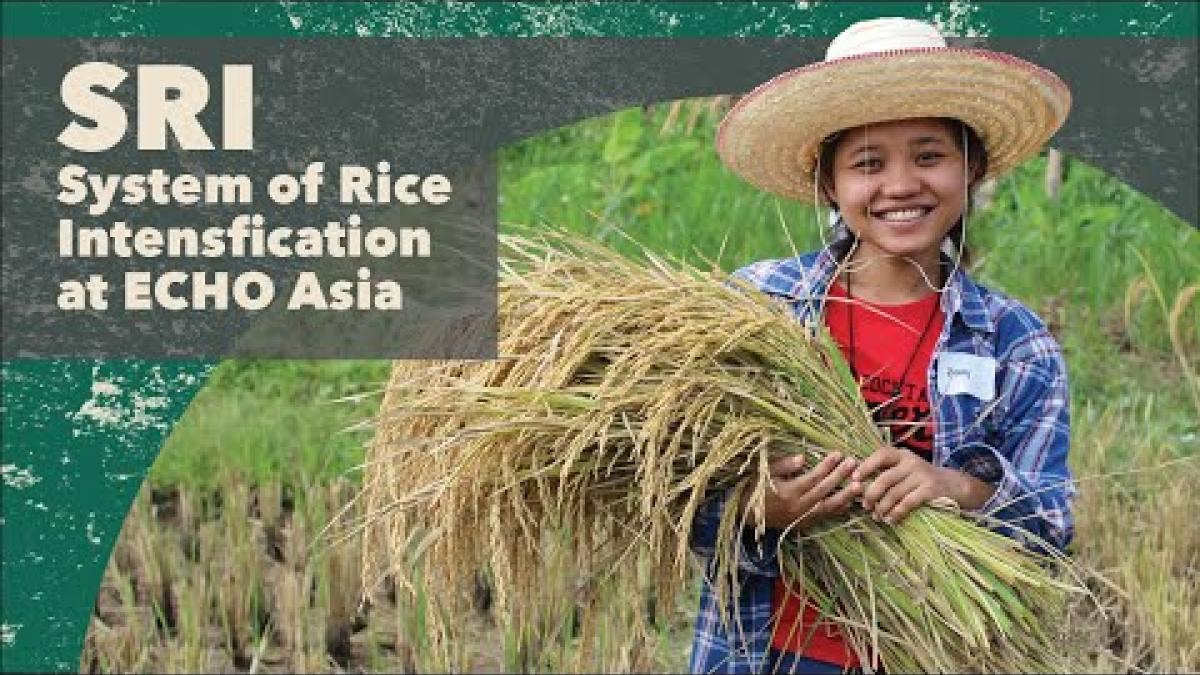
Top view from drone of green rice terrace field at mu cang chai, Vietnam.
Credit: ImpossiAble / Getty ImagesSystem of Rice Intensification
Transition to regenerative rice cultivation practices to lower greenhouse gas emissions, reduce chemical inputs, conserve water, and increase yields.
Rice is a staple crop for half the earth's population and is grown on more than a tenth of all arable land. More poor people depend on rice for food and income than any other crop. It is the foundation of culturally important dishes globally, from Japan to India to Brazil. However, conventional rice cultivation has major environmental impacts. Rice is grown by flooding paddies, which is wasteful of water and requires fossil fuel–based fertilizers and other chemicals to maintain yields, causing pollution. Microbes in flooded paddies generate methane, a potent greenhouse gas. Rice production accounts for 12 percent of all methane emissions globally and 2.5 percent of all greenhouse gases. System of Rice Intensification (SRI) is an agroecological alternative. It improves productivity by changing the management of plants, soil, and water, resulting in higher yields and fewer inputs. SRI can be implemented by any farmer. It lowers methane emissions, creates better resilience to weather extremes, and improves livelihoods. Financial investment and training for farmers are necessary to accelerate the adoption of SRI globally.
Action Items
Individuals
Learn about the challenges associated with conventional rice production and why SRI is a solution. The practice of flooding rice paddies is thousands of years old and is a way to control weeds. In addition to being a major contributor to global greenhouse gas emissions, conventional rice farming uses 10 percent of all synthetic nitrogen fertilizers globally, contributing to pollution. SRI is based on agroecological principles (see Agroecology Nexus). Although rice is a semiaquatic plant, it does not need continuous flooding. Instead, SRI (1) enriches soil with organic matter, such as manure or compost, rather than synthetic fertilizers; (2) spaces rice seedlings further apart, which strengthens roots; (3) applies water intermittently rather than continuously flooding; (4) uses manual weeders; and (5) applies natural pest management rather than toxic chemicals. Since its development in Madagascar in the 1980s, SRI techniques have been adopted in sixty countries. The benefits of SRI include:
- Improves yields. SRI produces larger and healthier plants with more rice per plant, with an average yield increase of 1.67 tons per hectare.
- Reduces methane emissions. With less field flooding, there is a reduced opportunity for methane-producing bacteria to exist. By reducing the amount of bacteria, methane emissions can be reduced by up to 70 percent.
- Conserves water. Globally, rice production is threatened by water scarcity, drought conditions, and increasing demand for water, particularly for agriculture. SRI reduces and even eliminates the amount of time that rice fields are flooded. In areas where drought is a potential problem, this conservation of water is vital. In Korea, SRI plays an important role in reducing water use by half. In Nepal, SRI is helping farmers to adapt to more frequent drought conditions.
- Reduces seeds. SRI can reduce the amount of rice seed needed by up to 90 percent. SRI seeds are collected from cultivated rice plants and then grown in an unflooded nursery in healthy soil. As a result, the need for seeds annually is greatly reduced over conventional methods.
- Reduces chemicals. The use of soil amendments, such as manure and compost, increases plant vitality and decreases the need for synthetic fertilizers. The use of pesticides is reduced because the widely spaced plants have lower disease rates, in contrast to densely packed seedlings in conventional systems. SRI reduces production costs for farmers, improving their livelihoods.
- Grows healthier rice. SRI’s use of increased plant spacing and soil amendments, such as organic compost, means the rice is more nutritionally dense than the same varieties grown conventionally.
Support growers by purchasing rice with a certification. Consumers have the power to let farmers know that their regeneratively grown rice is in high demand in the market. This can incentivize more farmers to make the transition to growing SRI rice.
- Lotus Foods is leading the way with its Regenerative Organic certification to ensure its rice is grown using the most sustainable practices. They work with local farmers in multiple countries to offer a guaranteed market for certified SRI rice.
- AgriCapture has a Climate Friendly Rice certification that lets the consumer know whether the rice was grown using sustainable practices.
- Preferred by Nature has partnered with the Sustainable Rice Platform label to identify farmers whose practices are proven to reduce greenhouse gas emissions and conserve water.
- Sustainable Rice Platform offers an SRP-Verified rice label—a science-based benchmark—to verify production claims. It is similar to SRI in basic principles, but standards are more specific, and the verification process covers a broad range of criteria.
Groups
Farmers
Learn the principles and techniques of the System of Rice Intensification. SRI methodologies are based on the understanding that rice does not need a flooded field to grow. SRI requires no additional investment in inputs and machinery, and site-specific and farmer-specific adaptations make SRI adoption affordable to small-scale rice farmers. The four foundations of SRI rice are:
- Start with young, healthy plants. With the SRI system, seedlings are planted earlier than in conventional paddy systems. This establishes the conditions for more abundant yields.
- Transplant single plants at optimal spacing. Rather than the high-density patterns of conventional planting, single-plant spacing allows for larger and healthier root systems, which translate to healthier plants with more rice per plant.
- Manage soil fertility naturally and organically. SRI calls for organic manure and/or compost to increase soil fertility, which reduces the need to purchase and apply synthetic fertilizers, reducing the amount of pollutants released into the ecosystem. Weeding fields instead of using pesticides reduces the farmers and the environment’s exposure to toxic chemicals.
- Use the minimum amount of water. SRI rice can thrive with a minimal amount of water. Besides conserving this important resource, it also encourages healthier plants and reduces the conditions that give rise to greenhouse gas emissions, such as methane.
Learn about the benefits of growing SRI rice. Practiced by millions of farmers around the world, SRI yields 50–100 percent more rice than conventional methods. The increased yield reduces the need for land clearing for new rice cultivation in order to maintain profitability. Seed use drops by 80–90 percent and water inputs by 25–50 percent. Labor requirements are lower once techniques have been integrated. Other benefits include:
- Increased yields. The major economic benefit of SRI rice is increased yields. An 86 percent yield increase was reported in Bihar, India, when using SRI techniques. The largest SRI research project to date, conducted in West Africa and involving five thousand farmers, documented a 56–86 percent increase in yield, with an average income increase of 41 percent.
- Better worker health. SRI reduces the amount of harmful synthetic fertilizers used, thus reducing nitrous oxide emissions and reducing harmful impacts on the health of water, soil, and farmers.
- Improved air quality. Alternative methods for disposing of the rice straw, such as recycling rice straw in the field rather than burning it, can improve local air quality while reducing the need for synthetic fertilizers and can be used with SRI.
- More farmer autonomy. SRI techniques typically use 70–80 percent less seed than paddy rice, making it possible for farmers to be less beholden to multinational seed companies. Farmers can save their own seeds and protect the thousands of locally adapted heirloom rice varieties that have been cultivated for generations.
- Greater resilience to climate change. SRI has been shown to enhance the health and strength of root systems and improve the overall ecology of the soil, making plants more nutrient-dense, higher yielding, and more resilient to changing climatic conditions. Also, an appreciable decrease in rice yields due to increased nighttime temperatures caused by overall warming has been demonstrated. Growing rice varieties that are bioregionally adapted or require less water can make small farmers more resilient.
- Higher incomes. A study in Vietnam saw a 15–20 percent increase in farmer income. The state of Tamil Nadu in India has a goal of increasing farmers' income threefold after a farmer using SRI techniques grew a record yield. When SRI is implemented with the use of intercropping, soil health is improved, while higher yields and diversified production lead to greater incomes for farmers.
Implement SRI rice production. There are a number of guides and manuals on how to implement SRI where you live. Here is an overview of general principles. Here is an overall report on SRI from Oxfam. Instruction manuals in different languages are available from the SRI International Network and Resource Center at Cornell University (see Learn/Books below for more info). You can also contact NGOs in your region for support (see Key Players). Other resources:
- Here is a guideline for tropical countries.
- Here is a case study from Mali.
- Here is a case study from Vietnam.
- Here is a technical manual for SRI in West Africa.
- Here are more case studies from the SRI International Network and Resource Center.
- Here is a list of how-to books on SRI.
NGOs
Collaborate with farmers and offer training in SRI. NGOs have been a major force in helping farmers access resources and transition to SRI farming methods. Learn from the NGOs listed in the Key Players section who are leading projects like these:
- OXFAM leads SRI training across the world. It trains farmers in Cambodia and Vietnam, helping family farmers become self-sufficient.
- The West Africa Agricultural Productivity Program trains thousands of farmers in SRI Techniques and helps them to share their knowledge with other interested farmers.
- ActionAid helps educate and train small-scale food producers and women farmers in Tanzania. This is important in a region where access to conventional sources of financing is limited.
- World Wildlife Fund educates and trains farmers in Malaysia, reducing their dependence on purchased fertilizers and helping to protect the health of their ecology.
- Partners NGO led a training of seventy-one farmers in Burma, and the Farmer Field School in northern Burma introduced one-third of the farmers there to SRI, which resulted in a 300 percent increase in yield. Within three years, those farmers began sharing their knowledge with others.
- The Sustainable Rice Platform not only offers a certification program but also offers training to farmers in SRI techniques and helps connect them to global markets in order to command higher prices while saving costs by adopting less resource-intensive practices.
- AgriCapture offers programs to help monetize sustainable practices on the farm, making it viable for farmers to move toward regenerative agriculture.
- SRI International Network and Resource Center connects farmers, NGOs, researchers, and educators who can share knowledge.
- Connect directly with other farmers on social media, such as the SRI Equipment Innovators Exchange on Facebook.
- The “Natural Farming” revolution in Japan, started by Masanobu Fukuoka and continued by Yoshikazu Kawaguchi, achieves high yields of rice while doing as little as possible to disrupt the natural ecology of the field. It approaches the cultivation of rice as not just work but a way of life.
Companies
Develop appropriate technology. In the transition from conventional paddy farming to SRI, farmers need different equipment for planting, weeding, and harvesting.
- Straw Innovations has developed a harvester that helps mitigate the environmental impacts of the burning of rice straw.
- Green and Seed Corporation has developed planting and mulching technology to make it easier for farmers to grow rice in non-flooded fields.
- Simple tools for weeding fields that are no longer being flooded, as outlined here, are needed by farmers to make the transition. EarthLinks is working with Cornell University on a project that will design and 3D print appropriate tools for SRI farmers and deliver them anywhere in the world.
Governance
Support local farmers through investments, education, and training. Over fifty countries signed the Global Methane Pledge at COP26 in Glasgow, pledging to reduce global methane emissions by 30 percent by 2030. Supporting and incentivizing farmers to acquire the knowledge and equipment to grow rice more sustainably is a vital step in lowering methane emissions.
- Policies and support from the Ministry of Agriculture and other government bodies in India have empowered farmers to rapidly transition to SRI in the state of Tripura.
- The USDA has pledged $90 million to develop more sustainable rice production in the United States, as well as to conduct research into the effectiveness of “Climate-Smart” rice production.
- Thailand is supporting 100,000 farming families to transition to SRI in an effort to reduce their methane emissions by offering loans, grants, and subsidies. The project, called NAMA (Nationally Appropriate Mitigation Action), can serve as a model for any government. It focuses on three key aspects of the transition: training farmers, supporting the development of businesses focused on helping farmers manage their farms, and crafting policies to develop and implement standards for sustainable rice.
- Vietnam has recognized that rice production is the most important aspect of its efforts to meet its pledge to reduce methane emissions. They have introduced 900,000 farmers to more sustainable techniques and aim to expand the program in the next five years.
- As an incentive to adopt more climate-friendly practices, rice growers in the U.S. who voluntarily shift to practices that reduce methane and other greenhouse gas emissions can have those emissions quantified, third-party verified, and sold in California's Carbon Market.
- Working with NGOs is key to spreading the benefits of SRI. The Vietnamese Ministry of Agriculture and Rural Development worked with Oxfam in helping farmers transition to SRI production, increase family incomes, and helping to teach farmers how to train others in SRI methods.
Key Players
Organizations
SRI-2030 (UK) is an initiative to rapidly expand the use of eco-friendly agricultural practices around the world, particularly the System of Rice Intensification.
OXFAM (Global) fights inequality to end poverty and injustice, including a focus on Systems of Rice Intensification.
CORAF (Senegal) focuses on innovations and technologies to boost agricultural and animal productivity.
AfricaRice (Africa) is a center of excellence for rice research, development, and capacity building.
EarthLinks (U.S.) is a non-profit organization with a 25 year commitment to protecting the environment and supporting sustainable, healthy communities.
Sustainable Rice Platform (Germany / Bangkok) is a global multi‐stakeholder alliance working to transform the global rice sector by improving smallholder livelihoods.
International Rice Research Institute (IRRI) (U.S.) is dedicated to abolishing poverty and hunger among people and populations that depend on rice-based agri-food systems.
SRI4Women (UK) is a media-based project aimed at bringing the testimonies of women rice farmers to a wider audience so the benefits of SRI can be better understood.
Learn
Watch
Earth, Food, Happiness [Official - Short Film on the Natural Farming] by City as Nature (20 mins.)
Professor Norman Uphoff on the System of Rice Intensification: What Has Been Learned? by SciencexMedia at Global Development (55 mins.)
System of Rice Intensification Bu Kiran News (10 mins.)
The Problem with Rice No One Is Talking About by DW Planet A (11 mins.)
A Look at the Contribution Rice Makes to Methane Emissions by AP Archive (5 mins.)
Climate-friendly Rice Farming in the Philippines by DW News (7 mins.)
SRI, Less Expensive and More Profitable by Agribusiness TV (5 mins.)
Read
More Rice for People, More Water for the Planet: System of Rice Intensification by Africare, Oxfam, and WWF
"The Role of System of Rice Intensification's Role in Hunger, Climate Change, and Communities" by Normal Uphoff / Foodtank
"System of Rice Intensification: A Solution to Methane Emissions and Food Insecurity" by Carlie Lai / Earth Org
The System of Rice Intensification: Frequently Asked Questions in Black and White by Norman Uphoff / CreateSpace Independent Publishing Platform
SRI Method of Paddy Cultivation: System of Rice Intensification by Anamika Nath, Utpal Dey, and N. S. Kute / LAP LAMBERT Academic Publishing
System of Rice Intensification: A New Way of Rice Cultivation by Mohd Salim Mir / LAP LAMBERT Academic Publishing
One-Straw Revolution: An Introduction to Natural Farming by Masanobu Fukuoka / NYRB Classics
One Straw Revolutionary: The Philosophy and Work of Masanobu Fukuoka by Larry Korn / Chelsea Green Publishing
Rice: Origin, Antiquity, and History by S. D. Sharma / CRC Press
The System of Rice Intensification: Memories of an Innovation by Norman Uphoff et. al / Self-Published
Listen
The Craft of Sustainable Rice Farming by the Craftsmanship Initiative (22 mins.)
Lotus Foods: The Story of Sustainable Rice by Heartland Stories Radio (29 mins.)
Share this page






